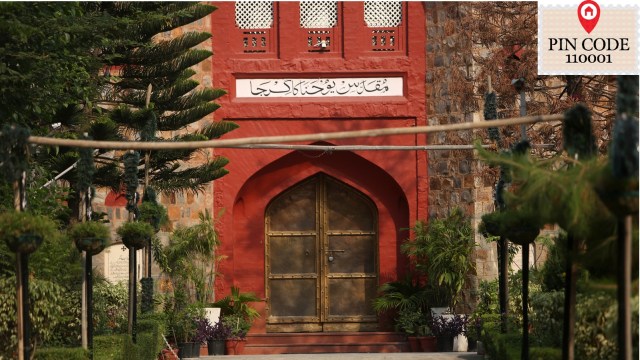Shikhara on top, Urdu name plaque: This church is a testament to Mehrauli’s diversity
Seen from a distance, the first thing about the church to catch one’s attention is a tall shikhara (spire seen on temples) adorned with a cross on its top.
 A white marble plaque on the church’s arched gateway announces ‘Moqaddas Yohna ka Girja’, which means the church of St John. (Express Photo by Gajendra Yadav)
A white marble plaque on the church’s arched gateway announces ‘Moqaddas Yohna ka Girja’, which means the church of St John. (Express Photo by Gajendra Yadav)There is nothing new or unique about stumbling upon a monument while walking through the historic village of Mehrauli. From Yogmaya temple to Khwaja Qutubuddin Bakhtiyar Kaki’s dargah, both revered by Mughal emperors in their time, the area in south Delhi is dotted with several age-old addresses, which underline the religious tolerance and cultural diversity of its residents.
Which is why, perhaps, it makes perfect sense that the area is also home to a church that bears features of a mosque as well as a temple. This is the St John’s Church, built in the 1920s on the ruins of a Mughal Fort.
Seen from a distance, the first thing about the church to catch one’s attention is a tall shikhara (spire seen on temples) adorned with a cross on its top.
According to Rana Safvi’s book, Where Stones Speak: Historical Trails in Mehrauli, the first city of Delhi: “The St John’s Church was built in 1922 on the ruins of a Mughal Fort under the aegis of their first pastor Rev.Hizkiel Porter… Taking the theme of religious tolerance further, it is worthwhile to note that the current structure incorporates the architectural features of a mosque, a temple and a church. It truly symbolises the syncretic culture of Mehrauli and India.”
A striking marker of syncretism is the name of the church written in Urdu on a white marble plaque on its arched gateway, announcing: “Moqaddas Yohna ka Girja”, which means the church of St John.
Speaking to The Indian Express, Umair Shah, a numismatist, said, “The plaque refers to St John as Yohna the way Jesus is called Eesah in Urdu. It was built at a time when there was a huge influence of the British in Delhi, around the time Lutyens’ Delhi was coming up. The only thing that makes this church stand out is the integration of three different cultures in its structure.”
Calling it the “most unique church in Delhi”, historian and writer Sam Dalrymple wrote in an Instagram post: “It’s definitely the only church that I’ve been to that’s won a qawwali competition… (it) was apparently designed by Alfred Coore — the architect who had earlier designed the Holy Trinity Church by Turkman Gate.”
He further wrote: “Coore was a fascinating man, and as nationalism began sweeping India, he obsessed over creating a distinctly Indian form of church architecture. He spoke of the ‘desire to realise Christianity in an Indian dress’ so that ‘churches would not simply be copies of English ones’.”
Author and Historian Swapna Liddle termed the church an example of “syncretist architecture”. She said, “It reflects the culture of the neighbourhood as Mehrauli is a mixture of people belonging to multiple cultures and religions.”
For Rameen Khan, who runs City Tales on Instagram, the church is an abode of peace near the “busiest intersection” of Mehrauli. “It is very close to Alai Darwaza (Qutub Minar) whose surface ornamentation boasts of intersection of cultures — the six-pointed star on the structure, for example. Though built over seven centuries later, this church, to me, feels like a worthy successor to Qutub Complex. It is everything that was wonderful about Delhi architecture once upon a time,” said Khan, who also conducts heritage walks.












